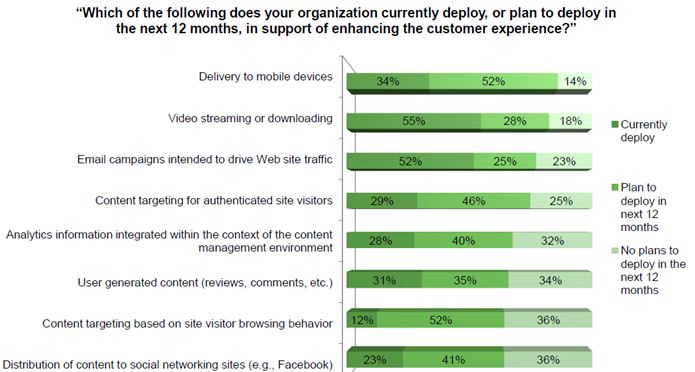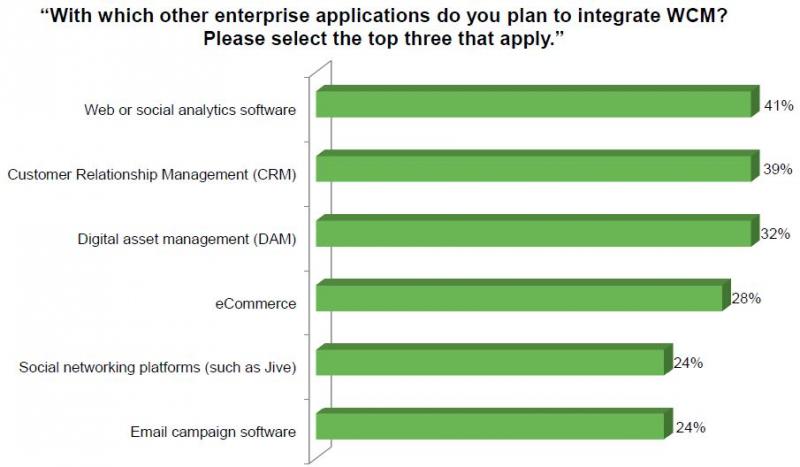Eight Areas You’ll Invest In For Great Digital Customer Experiences
There isn’t a sole, singular step companies and brands must follow to deliver engaging digital customer experiences. Website, mobile, social? Video streaming, content targeting, effective email campaigns, smarter analytics? Yes, please. And more of it.
Your challenge is finding the right mix (and prioritizing what makes sense) to make digital experience initiatives successful.
So let’s stipulate that in order differentiate with digital, you’ve got to consider what will get you there and establish priorities for your next budget cycle or next wave of strategic investment.
Although your priorities may vary, it’s instructive to see what other companies are investing in for better digital experiences.
You can get a clear view of this in recently available Forrester Research survey data. Earlier this year, Forrester surveyed 170 web content management professionals in a variety of industries asking for responses on what they have deployed, or plan to deploy in the next 12 months, to support online experiences.
Mobile content delivery, video streaming, email tools, and content targeting are high on the list of capabilities or near-term focus to serve digital experience requirements, according to respondents.
It’s important to note that even though we targeted our survey at WCM professionals, this does not mean they intend to source these capabilities from their existing WCM vendor. Many web content management software providers have done great work to retool their solutions to include many of the piece-parts that go into supporting digital experiences.
However, depending on the use case scenario, organizations should take a serious look at whether it’s better to use what’s already in their WCM of choice or look elsewhere for a proven, best-of-breed tool (or even a large suite) to integrate so they can address this critical opportunity.
So where are organizations investing today to support digital customer experiences?
The top eight areas of current or near-term deployments are shown in the Forrester graphic below.

Similarly, we asked the WCM pros about integrating other enterprise applications with web content management systems. The top six areas of integration plans are shown below. (For more results from the survey, please go here.)

It’s clear that organizations are prioritizing new investments in two key areas, above all else, in the short term. The first is delivering content to the mobile channel, and the second is enabling content targeting based on website visitor browsing behavior (followed closely by targeting content to authenticated users).
In regards to delivery to mobile devices, web content management vendors are evolving their offerings here, but many still lag behind the demands of content owners. These content owners (and marketers and line-of-business pros) have quickly realized that now that mobile is a massive reality, they need their WCM to be more efficient and less technical to create and deploy mobile content. Advice to WCM vendors: Get your R&D cranking to make it easy and more effective to create mobile-ready content.
Content targeting is another story. This is one of my favorite areas of digital innovation. The ability as a site owner to drive targeted content and offerings to customers and prospects based on something you know about them, implicitly or explicitly, when they visit you online or via mobile holds massive promise for engagement success, sales, and profits.
WCM vendors have been pushing hard their vision and capabilities to help deliver customized and personalized content using their systems, and many are already providing strong capabilities in this area. For many marketers and content pros, however, the technical capacity of a WCM system to manage and deliver targeted content to customers, prospects, and partners is outstripping marketers’ ability to take advantage of it. This can be complex. You need a plan. You need people responsible for the execution of the plan. It’s an ongoing commitment.
Translation: Despite a proliferation of powerful web content targeting technology (and the promise to deliver more engaging and profitable customer relationships), many organizations are not prepared adjust and evolve their digital marketing and content processes (not to mention their overall strategy) to enable this to happen.
If you intend to go this route, don’t expect the WCM vendor who sold you your software to hold your hand and show you how it’s done. To be successful, establish a targeting strategy, build a competency, allocate staff, create the content, and measure the results – and constantly think about how best to improve and optimize based on the data, week after week, month after month.